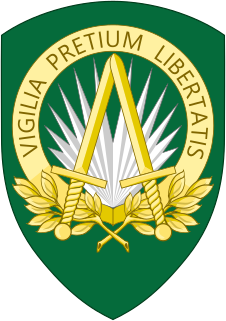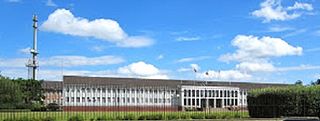
Ramstein Air Base or Ramstein AB is a United States Air Force base in Rhineland-Palatinate, a state in southwestern Germany. It serves as headquarters for the United States Air Forces in Europe – Air Forces Africa (USAFE-AFAFRICA) and also for NATO Allied Air Command (AIRCOM). Ramstein is located near the town of Ramstein-Miesenbach, which stands outside the base's west gate, in the rural district of Kaiserslautern.

Supreme Headquarters Allied Powers Europe (SHAPE) is the military headquarters of the North Atlantic Treaty Organization's (NATO) Allied Command Operations (ACO) that commands all NATO operations worldwide. ACO's and SHAPE's commander is titled Supreme Allied Commander Europe (SACEUR), a U.S. four-star general officer or flag officer who also serves as Commander, U.S. European Command. SHAPE is situated in Mons, Belgium.
An army group is a military organization consisting of several field armies, which is self-sufficient for indefinite periods. It is usually responsible for a particular geographic area. An army group is the largest field organization handled by a single commander – usually a full general or field marshal – and it generally includes between 400,000 and 1,000,000 soldiers.

Allied Joint Force Command Brunssum (JFCBS) is a NATO command with its headquarters at Brunssum, the Netherlands. It was established in 2004 from previous commands as part of NATO's continuing command structure reductions in the face of a then-diminishing threat.

Allied Forces Northern Europe (AFNORTH) was the northern Major Subordinate Command of NATO's Allied Command Europe (ACE), located at Kolsås outside Oslo. In the case of war with the Soviet Union, AFNORTH would assume supreme command of all Allied forces in northern Europe and Germany north of Elbe/Hamburg and adjacent sea territory.

JHQRheindahlen was a military base in Mönchengladbach, North Rhine-Westphalia, Germany active from 1954 to 2013. It functioned as the main headquarters for British forces in Germany and for the NATO Northern Army Group. Latterly it was also known as the Rheindahlen Military Complex, part of Rheindahlen Garrison. It was named after the local village of Rheindahlen, part of the city borough of Mönchengladbach.

Campbell Barracks, in Heidelberg, Germany, was home to Headquarters, United States Army Europe (USAREUR) from 1948 to 2013. It was also home to Headquarters, V Corps and Headquarters, Allied Force Command Heidelberg.

Allied Joint Force CommandNaples is a NATO military command based in Lago Patria, in the Metropolitan City of Naples, Italy. It was activated on 15 March 2004, after what was effectively a redesignation of its predecessor command, Allied Forces Southern Europe (AFSOUTH), originally formed in 1951. In NATO Military Command Structure terms, AFSOUTH was a "Major Subordinate Command". The commander of JFC Naples reports to the Supreme Allied Commander Europe at the Supreme Headquarters Allied Powers Europe, Casteau, Belgium.

Victor Eugene "Gene" Renuart Jr. is a retired United States Air Force four-star general. His last military assignment was as the commander of United States Northern Command and North American Aerospace Defense Command from March 23, 2007, to May 19, 2010. Prior to that, he served as director of strategic plans and policy, the Joint Staff. Renuart retired from the Air Force on July 1, 2010, after over 39 years of service.

The Allied Air Command (AIRCOM) is the central command of all NATO air and space forces and the Commander Allied Air Command is the prime air and space advisor to the Alliance. When directed by the Supreme Allied Commander Europe (SACEUR), it provides the core of the headquarters responsible for the conduct of air operations. The command is based at the Ramstein Air Base in Germany.

The 86th Air Division is a former designation of the 86th Airlift Wing, a United States Air Force organization. It was assigned to United States Air Forces in Europe at Ramstein Air Base, West Germany. It was inactivated on 14 November 1968. Its mission was the air defense of NATO-controlled airspace in Western Europe.

The Northern Army Group (NORTHAG) was a NATO military formation comprising four Western European Army Corps, during the Cold War as part of NATO's forward defence in the Federal Republic of Germany.

Headquarters Allied Force Command Heidelberg was a formation of the North Atlantic Treaty Organization (NATO) responsible for providing deployable joint staff elements (DJSE) in support of NATO operations worldwide. It was headquartered at Campbell Barracks, Germany, and reported to the Joint Force Command Brunssum (JFCBS). During the War on Terrorism, it provided command and control elements to the International Security Assistance Force (ISAF). It was disbanded on 1 April 2013.
The Structure of the North Atlantic Treaty Organisation is complex and multi-faceted. The decision-making body is the North Atlantic Council (NAC), and the member state representatives also sit on the Defence Policy and Planning Committee (DPPC) and the Nuclear Planning Group (NPG). Below that the Secretary General of NATO directs the civilian International Staff, that is divided into administrative divisions, offices and other organizations. Also responsible to the NAC, DPPC, and NPG are a host of committees that supervise the various NATO logistics and standardisation agencies.
Second Allied Tactical Air Force was a NATO military formation under Allied Air Forces Central Europe tasked with providing air support to NATO's Northern Army Group (NORTHAG). 2 ATAF commanded all flying units based within its sector and all reinforcements flying into its sector, as well as ground-based radar systems and stations, air defense units and the airfields in its sector.

Fourth Allied Tactical Air Force was a NATO military formation under Allied Air Forces Central Europe tasked with providing air support to NATO's Central Army Group (CENTAG). 4 ATAF commanded all flying units based within its sector and all reinforcements flying into its sector, as well as ground-based radar systems and stations, air defense units and the airfields in its sector.

NATO Headquarters Cannerberg / Joint Operations Centre (JOC), located behind the Château Neercanne south of Maastricht, on the border with Belgium, was, during the Cold War, a communications center and headquarters of NATO. It housed the war headquarters of Northern Army Group and Second Allied Tactical Air Force.
The following is a hierarchical outline for the elements of the United States Air Force in Europe at the end of the Cold War. It is intended to convey the connections and relationships between units and formations. In case of war with the Warsaw Pact, all would have been assigned to NATO.
Allied Land Forces Southern Europe (LANDSOUTH) was a military command of NATO's Allied Forces Southern Europe (AFSOUTH) command. Based in Verona in Northern Italy LANDSOUTH was tasked with defending Italy north of the Apennine mountains against a Warsaw Pact or Yugoslavian invasion. Activated in 1951 under an Italian Army four-star general, the command was disbanded in 2004.
The history of NATO begins in the immediate aftermath of World War II when British diplomacy set the stage to contain the Soviet Union and to stop the expansion of communism in Europe. The United Kingdom and France signed, in 1947, the Treaty of Dunkirk, a defensive pact, which was expanded in 1948 with the Treaty of Brussels to add the three Benelux countries and committed them to collective defense against an armed attack for fifty years. The British worked with Washington to expand the alliance into NATO in 1949, adding the United States and Canada as well as Italy, Portugal, Norway, Denmark, and Iceland. West Germany joined in 1955 and Spain joined in 1982.















